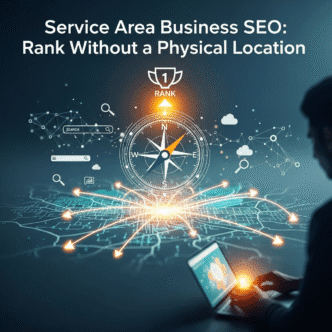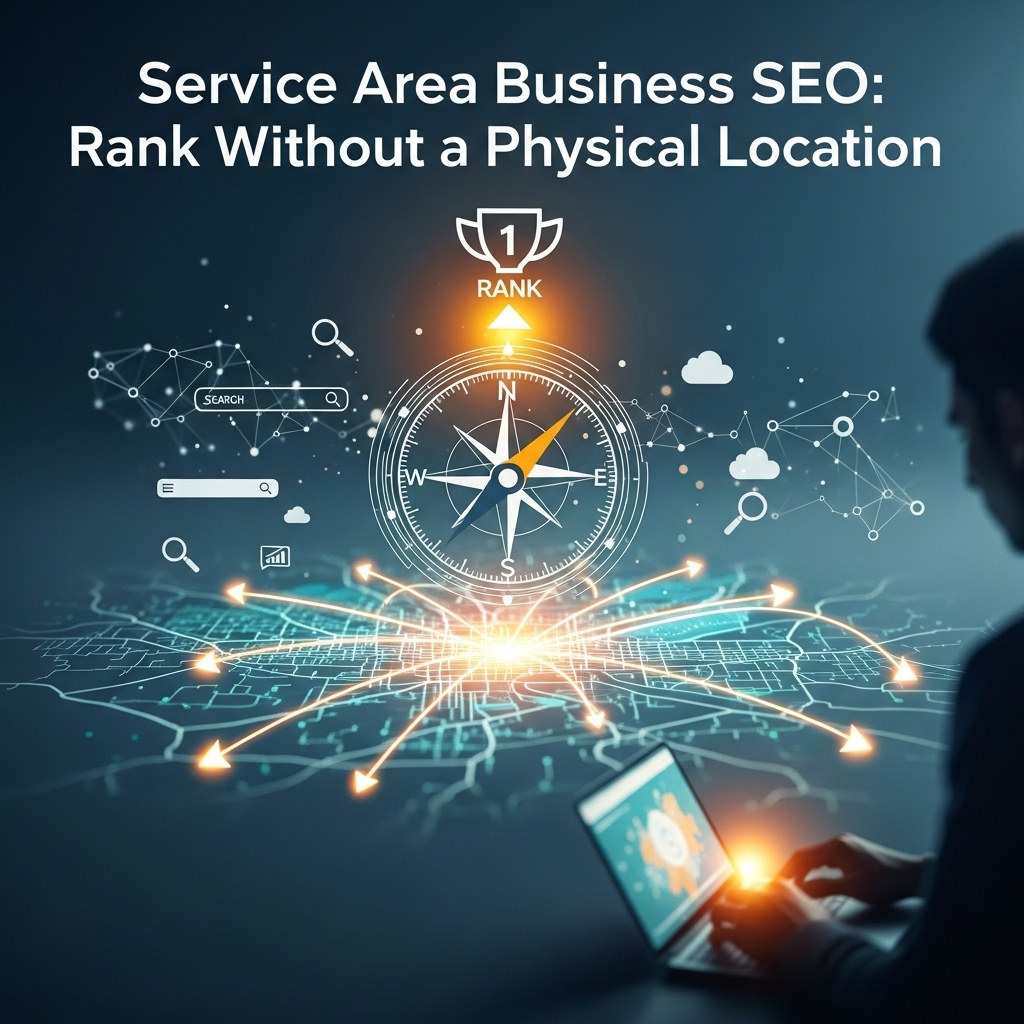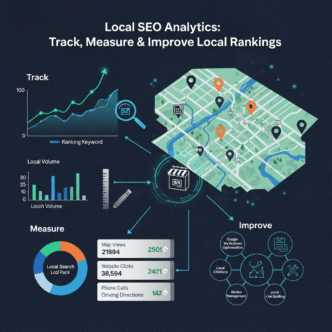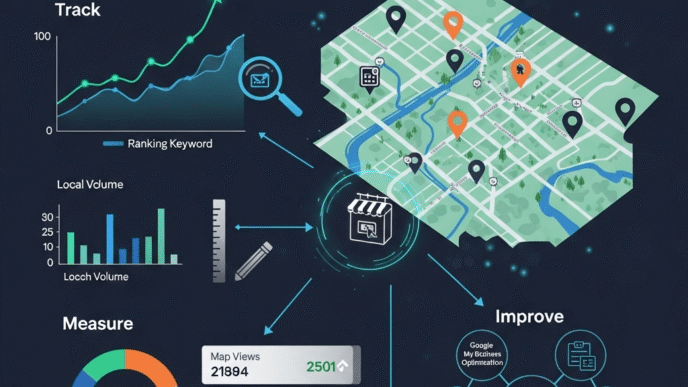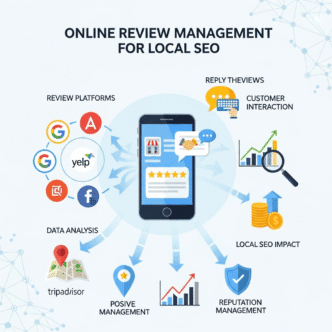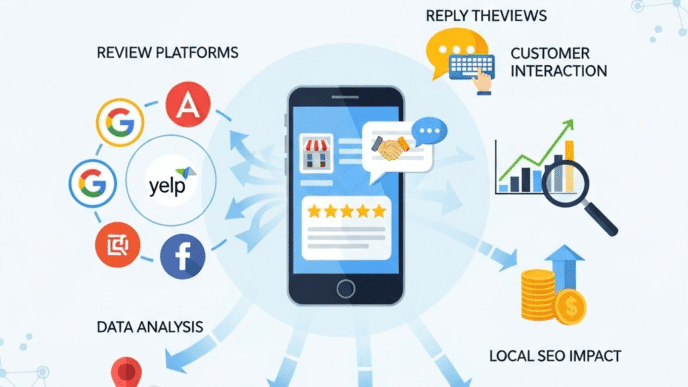You know what’s frustrating? Watching your competitors with fancy storefronts dominate Google Maps while you’re out there actually doing the work—fixing leaks, rewiring homes, or landscaping yards. No physical address? No problem. Well, actually… it is a problem if you don’t know how to handle service area business SEO correctly.
Here’s the deal: Google changed the game for mobile businesses, contractors, and service providers. You don’t need a brick-and-mortar location to rank locally anymore. But you do need a strategy that’s different from traditional local SEO.
This guide will show you exactly how to dominate local search results as a service area business in 2025—even if you operate from your truck, home office, or garage.
Table of Contents
ToggleWhat Is a Service Area Business (And Why SEO Is Different for You)?
Let’s start simple.
A service area business (SAB) is any company that travels to customers instead of having customers come to them. Think plumbers, electricians, house cleaners, mobile pet groomers, or HVAC technicians.
The difference? Traditional businesses rely on foot traffic and a public address. You rely on service calls and geographic coverage. That fundamentally changes how SEO for service businesses works.
Google knows you don’t have a lobby where customers walk in. So they’ve created specific rules for how SABs appear in local search results. Ignore these rules, and you’re invisible. Follow them, and you can outrank businesses with physical locations.
Examples of Service Area Businesses
- Plumbing and electrical contractors
- Roofing and construction companies
- Lawn care and landscaping services
- Mobile car detailing and mechanics
- House cleaning services
- HVAC technicians
- Pest control companies
- Locksmith services
All of these businesses share one thing: they need local SEO without address showing publicly.
Why Traditional Local SEO Doesn’t Work for Service Area Businesses
Here’s where most service businesses screw up.
They try to copy what retail stores and restaurants do—listing their home address, optimizing for that single location, and hoping for the best. Bad move.
The problem? Google penalizes SABs that try to manipulate their location. If you’re hiding your address but trying to rank for 20 different cities with fake locations, you’re toast.
The solution? A completely different approach to service area business SEO that focuses on service areas, not physical addresses.
What Makes SAB SEO Unique
Traditional businesses optimize around one location. Service area businesses need to optimize around multiple territories without appearing spammy. That requires:
- Strategic Google Business Profile setup
- Content targeting multiple service cities
- Location pages that don’t look duplicated
- Review strategies across service areas
- Local link building from each territory
It’s more complex, but the payoff is huge—you can rank in 5, 10, or even 20 cities simultaneously.
How to Set Up Your Google Business Profile for Service Area Business SEO
Your Google Business Profile (GBP) is ground zero for local SEO for plumbers electricians contractors and any other mobile service.
Here’s the step-by-step process:
Step 1: Create Your GBP with the Right Business Category
Choose your primary category carefully. This tells Google what you do and impacts when you appear in searches.
Examples:
- Plumber (not “Plumbing service”)
- Electrician (not “Electrical contractor”)
- HVAC contractor
- Roofing contractor
Add 2-3 secondary categories that are specific and relevant. But don’t keyword-stuff—Google catches that.
Step 2: Hide Your Address (But Keep Your Service Areas Visible)
This is critical for service area optimization.
When setting up your profile, you’ll have the option to hide your address and instead specify service areas. Do this:
- Go to your GBP dashboard
- Click “Edit profile”
- Select “I deliver goods and services to my customers”
- Choose “Hide my address”
- Add your service areas (cities, ZIP codes, or regions)
Pro Tip: Be honest about where you actually service. Google uses proximity as a ranking factor, so if you claim to service areas 100 miles away but never get reviews from those areas, Google will figure it out.
Step 3: Define Your Service Areas Strategically
You can list up to 20 service areas. Use them wisely.
Start with your core territories—the areas where you do 80% of your business. Then expand to adjacent cities where you’re willing to travel.
Example for a Denver plumber:
- Primary: Denver, Aurora, Lakewood
- Secondary: Littleton, Arvada, Westminster
- Tertiary: Boulder, Castle Rock (if you actually service them)
This approach helps with ranking locally as mobile service business without overextending.
Step 4: Optimize Your GBP Description
Your business description should include:
- What you do (obviously)
- Your service areas
- What makes you different
- Your focus keyword naturally
Bad description: “We are the best plumbers in Denver with 20 years of experience.”
Good description: “Family-owned plumbing company providing emergency repairs, water heater installation, and drain cleaning throughout Denver, Aurora, and Lakewood. Licensed, insured, and available 24/7 for service area business customers who need fast, reliable plumbing solutions.
See the difference? The second one includes service areas, services, and naturally incorporates service area business SEO concepts.
Creating Location Pages That Actually Rank (Without Being Spammy)
Here’s the million-dollar question: how to do local SEO without physical address across multiple cities?
Answer: Location-specific service pages.
These aren’t just copy-paste pages with different city names swapped in. Google hates that. Instead, create genuinely useful, unique content for each service area.
The Location Page Formula
Each service area page should include:
- Unique introduction mentioning the specific city
- Local landmarks, neighborhoods, or ZIP codes
- Service-specific content relevant to that area
- Local testimonials or case studies
- City-specific FAQs
- Embedded Google Map showing the service area
Example structure for “Plumbing Services in Aurora, CO”:
H2: Professional Plumbing Services in Aurora, Colorado
“Aurora homeowners face unique plumbing challenges—from older pipe systems in North Aurora to hard water issues near the Aurora Reservoir. Our licensed plumbers service all Aurora neighborhoods, including Saddle Rock, Southlands, and Fitzsimons.”
H3: Why Aurora Residents Choose [Your Company]
- 24/7 emergency service to all Aurora ZIP codes (80010-80019)
- Average 45-minute response time in Aurora
- Licensed to work on Aurora’s specific plumbing codes
H3: Common Plumbing Issues in Aurora Homes
- Hard water damage (very specific to area)
- Sewer line problems in older Aurora neighborhoods
- Water heater failures during Colorado winters
See how this isn’t just a template? It’s genuinely useful for someone in Aurora. That’s what ranks.
How Many Location Pages Should You Create?
Only create pages for areas where you actually do business regularly. Here’s a good rule:
- Tier 1: Your primary 3-5 cities (full location pages with 1,000+ words)
- Tier 2: Your secondary 5-10 cities (medium pages with 600-800 words)
- Tier 3: Mention other service areas in your main service pages
This balances coverage with quality, which is essential for mobile business SEO.
Content Strategy for Service Area Business SEO
Beyond location pages, you need content that demonstrates expertise and attracts links.
Blog Content That Ranks
Focus on local + service combinations:
- “5 Signs You Need Emergency Plumbing in [City]”
- “How Much Does [Service] Cost in [City]?”
- “Choosing a [Service Type] in [City]: What to Look For”
- “[City] Building Codes: What Homeowners Need to Know”
- “Seasonal [Service] Tips for [City] Homeowners”
These target long-tail keywords like “how much does furnace repair cost in Denver” while establishing local authority.
Real-World Example: Case Study
Business: Mike’s Mobile Mechanic (Phoenix, AZ)
Challenge: Couldn’t rank because he operated from home and serviced 15 cities
Strategy:
- Created 8 detailed location pages for primary service areas
- Published weekly blog content about car maintenance in Phoenix heat
- Got featured in local news for mobile service during pandemic
- Built citations in Phoenix-area directories
- Collected reviews from each service city
Results: Within 6 months, ranking in top 3 for “mobile mechanic [city name]” in 5 different Phoenix suburbs. Monthly service calls increased 240%.
The key? He didn’t try to fake multiple locations. He built genuine local authority through content and community engagement.
Building Citations and Local Links Without an Address
Citations are mentions of your business name, phone number, and website on other sites. They’re crucial for local SEO without address validation.
Citation Strategy for SABs
Use your service area as your “location”
- Business name: ABC Plumbing
- Location: “Serving Denver Metro Area” (not a specific address)
Target these citation sources:
- Yelp, Angi (formerly Angie’s List), HomeAdvisor
- Better Business Bureau
- Industry-specific directories (Plumbers.com, etc.)
- Local chamber of commerce websites
- Nextdoor Business Pages
Keep NAP consistent:
- Name: Exactly the same everywhere
- Phone: Same number everywhere
- Service areas: Consistent list of cities
Pro Tip: Don’t list your home address publicly unless you run a home-based office that accepts clients. For most SABs, omitting the street address is perfectly acceptable.
Local Link Building for Service Businesses
Links from local websites pass serious SEO juice for contractor SEO. Here’s how to get them:
Sponsor local events:
- Youth sports teams
- Community fundraisers
- Neighborhood associations
Get featured in local news:
- Offer expert commentary on your industry
- Announce community service projects
- Share unique local statistics or trends
Partner with complementary businesses:
- Plumbers + HVAC companies
- Electricians + Solar installers
- Landscapers + Outdoor lighting companies
Create link-worthy local resources:
- “[City] Home Maintenance Calendar”
- “Directory of Licensed [Service] Professionals in [City]”
- “[City] Building Permit Guide”
These resources naturally attract links from local bloggers, real estate agents, and community websites.
Reviews: The Secret Weapon for Service Area Business SEO
Reviews are 10x more important for SABs than traditional businesses.
Why? Because Google uses review signals to verify you actually service the areas you claim. If you say you service 10 cities but all your reviews are from one ZIP code, Houston, we have a problem.
Review Strategy Across Multiple Service Areas
1. Ask for reviews immediately after service
Send a text or email with a direct link to your Google review page while you’re still top-of-mind.
Sample text: “Hi [Name]! Thanks for choosing [Business] for your [service] in [City]. If you were happy with our work, we’d love a quick Google review: [link]. It really helps local homeowners find us!”
2. Encourage location mentions in reviews
The best reviews naturally mention the city or neighborhood:
- “Quick response to our Lakewood home”
- “Best electrician in Aurora”
- “Fixed our furnace in Littleton within 2 hours”
These location-specific reviews dramatically boost your service area business Google Business Profile relevance.
3. Respond to every review
Always mention the location in your response:
“Thanks for the review, Jennifer! We’re glad we could help with your plumbing emergency in Westminster. We’re always here when your neighbors need reliable service!”
This reinforces to Google (and potential customers) that you’re active in that area.
Review Comparison: What Works Best
| Review Strategy | Impact on Local Rankings | Difficulty | Time Investment |
|---|---|---|---|
| Generic “please leave a review” | Low | Easy | 5 min/customer |
| Automated review request system | Medium | Medium | Setup: 2 hours |
| Personalized requests with location mention | High | Medium | 10 min/customer |
| In-person review request with QR code | Very High | Easy | 2 min/customer |
| Review generation from multiple service areas | Very High | High | Ongoing effort |
The winner? In-person QR code requests combined with location-specific follow-ups. This generates the most authentic, location-rich reviews.
Technical SEO Essentials for Service Area Businesses
Don’t skip the technical stuff—it’s the foundation of SEO for businesses that travel to clients.
Schema Markup for SABs
Implement LocalBusiness schema on your homepage and location pages. This tells search engines exactly what you do and where you serve.
Key schema properties for SABs:
- @type: “LocalBusiness” or specific type (Plumber, Electrician, etc.)
- areaServed: Array of cities/regions
- serviceArea: Specific geographic areas
- telephone: Your business phone
- priceRange: Typical price range ($$, $$$, etc.)
You can use Google’s Schema Markup Generator to create proper code.
Mobile Optimization Is Non-Negotiable
87% of service area business searches happen on mobile. If your site isn’t mobile-friendly, you’re losing money.
Mobile checklist:
- ✅ Click-to-call phone numbers
- ✅ Fast loading (under 3 seconds)
- ✅ Easy navigation
- ✅ Legible text without zooming
- ✅ Touch-friendly buttons
- ✅ Minimal pop-ups
Test your site with Google’s Mobile-Friendly Test.
Site Speed Matters More Than You Think
Slow sites = lost customers. Period.
Target metrics:
- Largest Contentful Paint (LCP): Under 2.5 seconds
- First Input Delay (FID): Under 100ms
- Cumulative Layout Shift (CLS): Under 0.1
Use PageSpeed Insights to check your scores and get specific recommendations.
Common Service Area Business SEO Mistakes (And How to Avoid Them)
Let’s talk about what not to do.
Mistake #1: Listing Fake Addresses
Some businesses rent virtual offices or use PO boxes in multiple cities to create the illusion of multiple locations.
Don’t do this. Google will eventually catch you, and the penalty is brutal—complete removal from local search results.
Mistake #2: Keyword-Stuffed Location Pages
Creating 20 nearly identical pages with just the city name swapped out?
Google sees through this instantly. Each location page needs unique, valuable content.
Mistake #3: Ignoring Review Diversity
If you claim to service 15 cities but have zero reviews mentioning 10 of them, Google assumes you don’t actually service those areas.
Build review diversity intentionally across your entire service area.
Mistake #4: Neglecting Content Updates
Publishing 5 blog posts in January then ghosting your site the rest of the year signals to Google that your business might be inactive.
Maintain a consistent publishing schedule—even if it’s just once per month.
Mistake #5: Forgetting About Local SEO Fundamentals
All the SAB-specific strategies work on top of solid local SEO basics. Don’t skip foundational elements like optimizing your website structure, building quality backlinks, and maintaining consistent NAP information.
For comprehensive guidance on local SEO basics, check out this detailed guide on mastering local search optimization. It covers everything from Google Business Profile optimization to advanced ranking factors.
Advanced Strategies: Taking Your Service Area Business SEO to the Next Level
Ready to dominate? Here are tactics the pros use.
Strategy 1: Hyper-Local Content Clusters
Instead of standalone location pages, build content clusters around each major service area.
Example for a Denver electrician:
Main page: “Electrical Services in Denver” Supporting content:
- “Denver Electrical Code Updates 2025”
- “Historic Home Wiring in Downtown Denver”
- “Solar Panel Installation in Denver: What You Need to Know”
- “Emergency Electrician in Denver: Response Time Comparison”
Each piece links back to the main Denver service page, creating a topical authority hub. This approach dramatically improves your service area optimization for that city.
Strategy 2: Local PR and Digital PR Campaigns
Get mentioned in local news outlets, blogs, and industry publications.
Tactics that work:
- Create newsworthy local surveys (“80% of Denver homeowners neglect this critical safety check”)
- Offer expert commentary on local news stories
- Sponsor local charity events and get coverage
- Create shareable local infographics
Each mention and link strengthens your local authority signals.
Strategy 3: Video Content for Local Rankings
Video is crushing it in local search results right now.
Create videos like:
- “Day in the life of a [your city] [your service]”
- “Common [service] problems in [city]”
- Customer testimonials (with permission) mentioning their location
- Quick tips and how-tos
Optimize with location keywords in titles, descriptions, and tags. Upload to YouTube and embed on relevant location pages.
Pro Tip: Videos with local landmarks in the background (even just briefly) help establish geographic relevance to Google’s AI.
Strategy 4: Strategic Service Area Expansion
Don’t try to rank everywhere at once. Use this expansion framework:
Phase 1: Master your primary 3-5 cities (Months 1-6)
- Create detailed location pages
- Build strong review base in each area
- Generate local content and links
Phase 2: Expand to adjacent territories (Months 7-12)
- Add 5-7 secondary service areas
- Create medium-depth location pages
- Leverage existing authority to rank faster
Phase 3: Cover remaining service territory (Month 13+)
- Fill in gaps with lighter location pages
- Maintain content and review generation
- Focus on long-tail opportunities
This methodical approach prevents spreading yourself too thin and delivers better results than trying to rank in 20 cities simultaneously.
Measuring Success: KPIs That Actually Matter
Track these metrics to know if your service area business SEO is working:
Primary KPIs
1. Google Business Profile Views
- Broken down by city
- Track month-over-month growth
- Goal: 20%+ increase quarterly
2. Website Sessions from Organic Local Search
- Filter by landing pages (location pages)
- Track which cities drive most traffic
- Goal: Consistent growth across all service areas
3. Phone Calls from Organic Search
- Use call tracking to attribute calls to specific landing pages
- Identify which locations convert best
- Goal: Improved call quality and volume
4. Service Requests/Quote Requests
- Track form submissions by location
- Monitor conversion rate by service area
- Goal: 3-5% conversion rate from local traffic
Secondary KPIs
5. Ranking Positions
- Track “[service] in [city]” rankings for all service areas
- Use tools like BrightLocal or Local Falcon
- Goal: Top 3 positions in primary cities, top 10 in secondary cities
6. Review Metrics
- Total reviews across all platforms
- Average rating (maintain 4.5+ stars)
- Review velocity (reviews per month)
- Geographic distribution of reviews
7. Citation Consistency Score
- Use Moz Local or BrightLocal to scan
- Goal: 95%+ consistency across directories
Tracking Tools Comparison
| Tool | Best For | Price Range | Key Feature |
|---|---|---|---|
| Google Analytics 4 | Website traffic analysis | Free | Service area traffic breakdown |
| Google Business Profile Insights | GBP performance | Free | Direct Google data |
| BrightLocal | Citation management & ranking | $35-$200/mo | Multi-location tracking |
| Local Falcon | Precise local ranking | $30-$105/mo | Grid-based rank tracking |
| CallRail | Call tracking | $45-$145/mo | Source attribution |
| SEMrush | Comprehensive SEO | $130-$500/mo | Competitive analysis |
| Whitespark | Citation building | $35-$300/mo | Local search expertise |
Pro Tip: Start with free tools (Google Analytics, GBP Insights) then add paid tools as your business grows and ROI from SEO becomes clear.
The 90-Day Service Area Business SEO Action Plan
Let’s make this practical. Here’s exactly what to do in your first 90 days.
Month 1: Foundation
Week 1-2: Google Business Profile
- Create/optimize GBP
- Add service areas
- Upload photos
- Set up messaging
- Publish first 3 posts
Week 3-4: Website Optimization
- Fix technical issues (speed, mobile, schema)
- Create/optimize 3 priority location pages
- Install call tracking
- Set up Google Analytics 4 with location tracking
Month 2: Content & Citations
Week 5-6: Content Creation
- Publish 2 location-specific blog posts
- Create service-specific pages if missing
- Add FAQ sections to location pages
- Embed Google Maps on location pages
Week 7-8: Citation Building
- Submit to top 15 directories
- Claim existing citations
- Ensure NAP consistency
- Join local business associations
Month 3: Growth & Optimization
Week 9-10: Review Generation
- Implement review request system
- Ask 20+ customers for reviews
- Respond to all existing reviews
- Create review landing page
Week 11-12: Link Building & Analysis
- Reach out for 5 local partnership links
- Create one link-worthy resource
- Analyze results from first 90 days
- Adjust strategy based on data
Pro Tip: Don’t try to do everything at once. Focus on one task per day, and you’ll make consistent progress without burning out.
Real Success Stories: Service Businesses Winning with Local SEO
Let’s look at actual businesses crushing it.
Success Story #1: Elite HVAC Services (Dallas, TX)
Background: Small HVAC company competing against corporate franchises
Strategy:
- Created 12 detailed location pages for Dallas suburbs
- Published seasonal content (Texas heat angles)
- Generated 150+ reviews in 6 months
- Built partnerships with local real estate agents
Results:
- 340% increase in organic traffic
- #1 ranking for “emergency AC repair [city]” in 8 locations
- Service calls increased from 45/month to 190/month
- Hired 3 additional technicians to handle demand
Key takeaway: Detailed location pages + seasonal content = local dominance
Success Story #2: ProClean Mobile Detailing (Seattle, WA)
Background: One-person mobile car detailing service
Strategy:
- Optimized GBP with service areas only
- Created video content showing work at Seattle landmarks
- Partnered with local car dealerships for referrals
- Used Nextdoor for hyperlocal marketing
Results:
- Ranking in top 3 for “mobile car detailing Seattle” and 6 suburbs
- 50+ 5-star reviews in first year
- Booked out 3 weeks in advance
- Revenue increased 280%
Key takeaway: Video content + community engagement = trust and rankings
Success Story #3: Rapid Response Plumbing (Phoenix, AZ)
Background: Established plumbing company stuck in ranking plateau
Strategy:
- Complete website redesign focused on speed (3.2s → 1.1s load time)
- Implemented emergency service landing pages for each area
- Started “Plumber Q&A” video series
- Aggressive review generation campaign
Results:
- 25% improvement in GBP views
- 180% increase in emergency service calls
- Expanded from 8 to 15 service areas
- Average job value increased due to authority positioning
Key takeaway: Speed + emergency optimization = high-intent traffic
Future-Proofing Your Service Area Business SEO for 2025 and Beyond
SEO isn’t static. Here’s what’s coming and how to prepare.
Trend #1: AI-Powered Search Experiences
Google’s AI Overviews (formerly SGE) are changing how results appear. Your content needs to be:
- Question-focused (people ask AI questions)
- Concise and direct (AI prefers clear answers)
- Authoritative (AI sources credible content)
Action: Restructure content with clear questions as H2s and direct answers immediately following.
Trend #2: Voice Search Optimization
“Hey Siri, find a plumber near me” isn’t going away.
- Using natural, conversational language
- Answering specific questions completely
- Including long-tail question phrases
- Ensuring your GBP has complete information
Action: Create FAQ pages targeting conversational queries like “who’s the best electrician in [city]” or “how much does [service] cost near me.”
Trend #3: Hyperlocal Targeting
Google is getting better at understanding neighborhoods, not just cities.
Action: Mention specific neighborhoods, landmarks, and ZIP codes in your content. “Serving Cherry Creek, Capitol Hill, and LoDo neighborhoods” is better than just “Serving Denver.”
Trend #4: Sustainability and Social Responsibility
Consumers increasingly choose businesses aligned with their values.
Action: If applicable, highlight:
- Eco-friendly practices
- Community involvement
- Local partnerships
- Employee welfare
This isn’t just good business—it’s link-worthy content that attracts local press and backlinks.
Trend #5: Review Authenticity Enforcement
Google is cracking down on fake reviews harder than ever.
Action: Only request genuine reviews from real customers. Document your service with photos and timestamps to verify authenticity if ever questioned.
Tools and Resources for Service Area Business SEO Success
Here are the tools worth investing in:
Essential Free Tools
- Google Business Profile: Your #1 priority
- Google Analytics 4: Track website performance
- Google Search Console: Monitor search visibility
- PageSpeed Insights: Check site speed
- Ubersuggest: Basic keyword research
- Google Keyword Planner: Search volume data
Paid Tools Worth the Investment
For rankings and tracking:
- BrightLocal (best for multi-location tracking)
- Local Falcon (best for visualizing local pack rankings)
For citations:
- Whitespark Local Citation Finder
- Moz Local
For reviews:
- Podium
- Birdeye
- NiceJob
For comprehensive SEO:
- SEMrush (all-in-one)
- Ahrefs (best for link analysis)
For call tracking:
- CallRail
- CallTrackingMetrics
Learning Resources
- Google’s Local Business Guidelines
- Local Search Ranking Factors Study by Whitespark
- BrightLocal’s Local SEO Blog
Want more comprehensive guidance? The Complete Guide to Local SEO covers fundamentals that apply to all local businesses, including service area businesses.
Frequently Asked Questions About Service Area Business SEO
Can I rank in Google Maps without a physical address?
Yes! Service area businesses can absolutely rank in the local map pack (the 3 results shown on Google Maps). You just need to hide your address in Google Business Profile and specify your service areas instead. Google shows SABs in local results based on service areas, not physical locations.
How many service areas can I list on Google Business Profile?
Google allows up to 20 service areas. However, quality beats quantity—only list areas where you actively do business and can generate reviews from customers.
Should I create separate Google Business Profiles for each city I serve?
No, absolutely not. This violates Google’s guidelines and will get all your listings suspended. Service area businesses should have ONE GBP listing their actual location (hidden) with multiple service areas specified.
How long does it take to rank for service area business SEO?
Expect 3-6 months to see significant movement. Your primary service areas (where you have the most reviews and activity) may rank faster—sometimes within 60-90 days. Secondary service areas typically take longer (6-12 months).
Do I need different websites for each city I serve?
No. One website with separate location pages for each service area is the best approach. Multiple websites creates management headaches and dilutes your domain authority.
How do I get reviews from different service areas?
Simple: ask every customer for a review and encourage them to mention their location. Send review requests immediately after completing service in each area. Over time, this builds geographic diversity in your review profile.
Can I use my home address for my service area business?
You can, but you don’t have to show it publicly. If you run your business from home and don’t have clients visiting, hide your address and list service areas only. If you have a home office where clients do visit occasionally, you can show your address.
What if my competitor is using fake addresses to rank in multiple cities?
Report them to Google through the Business Redressal Complaint Form. Businesses using fake addresses violate Google’s guidelines. That said, focus on your own legitimate strategy rather than obsessing over competitors.
How important are backlinks for service area business SEO?
Very important. Local backlinks from reputable sites in your service areas (chambers of commerce, local news, community organizations) significantly boost your authority. Quality matters more than quantity—10 links from legitimate local sources beat 100 from random directories.
Should I pay for advertising in addition to SEO?
Pro Tip: In the beginning, yes. Google Local Services Ads and Google Ads can generate immediate leads while your SEO efforts build momentum. Once you’re ranking organically, you can reduce ad spend. Many successful SABs run a combination of both for maximum visibility.
Final Thoughts: Your Service Area Business SEO Game Plan
Here’s the truth: service area business SEO isn’t harder than traditional local SEO—it’s just different.
You don’t need a fancy storefront to dominate local search. You need a strategic approach that works with Google’s guidelines instead of against them.
Start with the fundamentals:
- Optimize your Google Business Profile correctly (hide address, list service areas)
- Create unique, valuable location pages for your primary service areas
- Generate reviews from customers across your entire service territory
- Build local citations and links consistently
- Publish helpful local content regularly
The businesses winning in local search aren’t necessarily the biggest or the oldest—they’re the ones who understand how local SEO for plumbers electricians contractors and other service businesses actually works in 2025.
Stop comparing yourself to businesses with physical locations. You’re playing a different game, and frankly, you have an advantage—you can rank in 10 cities while they’re stuck optimizing for one address.
Want to dive deeper into the foundational strategies that work for all local businesses? Check out this comprehensive resource on mastering local search visibility. It’s packed with actionable tactics that complement everything you’ve learned here.
Now get out there and claim your territory—one service area at a time.
What’s your biggest challenge with service area business SEO? Are you struggling with reviews, ranking in multiple cities, or something else? The strategies in this guide work, but execution is everything. Start with one city, master it, then expand. You’ve got this.
Related posts:
- Local SEO Mastery: The Complete Guide to Dominating Local Search in 2025 (Visual guide)
- Google Business Profile Optimization: Complete 2025 Setup Guide
- Multi-Location SEO Strategy: Rank Multiple Business Locations in 2025
- Local SEO in Competitive Markets: Outrank Established Competitors in 2025 (Visual guide)

